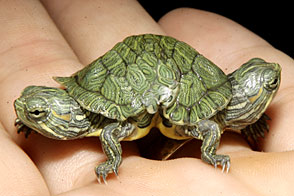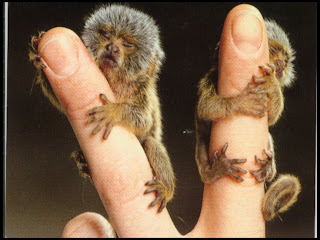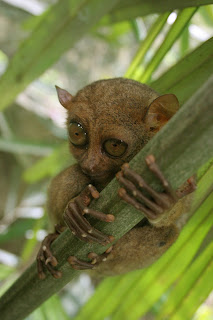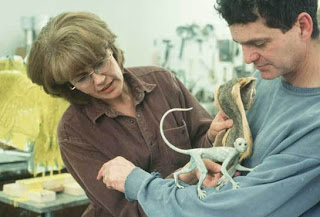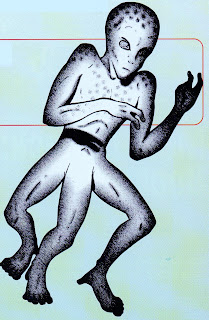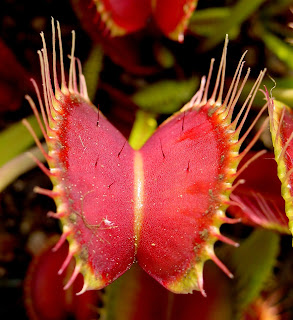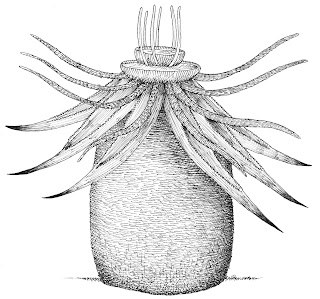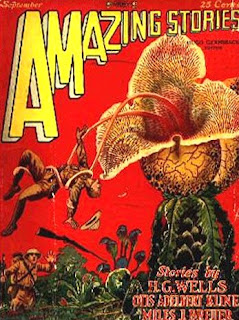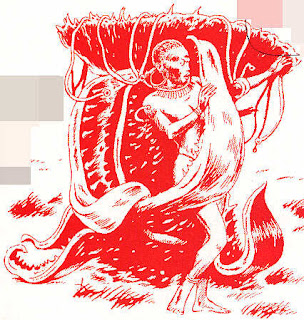West Virginia's bizarre 'Vegetable Man' entity (John A. Short, Alien Encounters, August 1997)
Exobiology - the study of life on other worlds, featuring speculation upon the morphological forms that such life may take, based upon their worlds' environmental constraints - has always fascinated me. So here, just for a change from considering cryptozoological topics and other subjects appertaining to life on our own planet, here is a look at what else may be sharing our universe and even visiting us from time to time...
The Gray or Grey may well be the most familiar form of alleged alien visitor on record, but it is by no means the only one. As revealed in Patrick Huyghe's invaluable Field Guide to Extraterrestrials (1997) and elsewhere, ETs apparently come in all shapes and sizes, yet most receive far less attention from researchers than the Gray. Consequently, here in no particular order is my personal top ten of the strangest alleged extraterrestrial life forms reported, all of which are truly alien - in every sense of the word!
UNIPODAL ALIEN ROBOTS?
One of the least humanoid categories of ETs ever reported must surely be the astonishing version reputedly encountered by Brazilian bus driver Antonio La Rubia at 2.20 am one morning in September 1977 while driving to work in Paciencia, Rio de Janeiro. After spying a huge hat-shaped vessel exceeding 200 ft in diameter hovering above a football field, La Rubia was abruptly immobilised by a beam of blue light, and then saw three decidedly futuristic robotic entities, who transported him inside the vessel. Here, he was subjected not only to the customary alien examination but also to a slide show of sorts, before being somewhat rudely ejected back into the street again, after which the craft disappeared.
Sketch by Antonio La Rubia of one of the unipodal entities that he claims to have encountered (APRO Bulletin)
This scenario may be a common one to ufologists, but La Rubia's abductors were decidedly uncommon in appearance. Each was about 4 ft tall, excluding the vertical antenna on top of a featureless head shaped like a rugby ball standing erect on its tip, and equipped with a horizontal belt of blue mirror-like structures encircling its diameter. Beneath its head, which had no neck, was a sturdy ovoid body covered in scales resembling dull aluminium. It also had a waist-high belt bearing a series of hooks holding syringe-like objects, plus two arm-like appendages that curved downwards but terminated in a point, lacking hands. Its body was borne upon a tall, slim, central pedestal, with a circular base at its tip.
THE DISEMBODIED BRAINS AT PALOS VERDES
Bodiless brains are not the most appetising of sights at the best of times, and certainly not when they float towards you and begin communicating telepathically as you sit in your car on a lonely Californian road at 2 am in the morning! Nevertheless, this bizarre scenario was supposedly experienced by two men in their early 20s, known pseudonymously as John Hodges and Peter Rodriguez, sometime in August 1971 at Palos Verdes Estates, California.
While walking towards their car, they had seen a diffuse white beam close by, and once inside the car their headlights had revealed two grotesque brain-resembling entities hovering in the air outside. Both were blue in colour, but whereas one was only the size of a softball, the other was about 18 in high, and bore a large bright red spot on its surface.
The two men lost no time in driving away, and Hodges took Rodriguez home, but in the classic abduction tradition, after reaching his own home Hodges discovered that he had mysteriously 'lost' two hours. Later, he recalled experiencing a dream-like state while in his car, during which he seemed to be in a room containing not only the larger of the two levitating brains but also several tall, grey, six-fingered, humanoid (yet non-human) entities. The brain informed him that Earth was being monitored because of its nuclear power; the humanoid entities claimed that they were from Zeta Reticulii, and that the brains were translators. They also voiced a number of prophecies, but these proved to be inaccurate.
THE CRAZY CRITTER OF BALD MOUNTAIN
This was the name applied by the local media to the incredible beast confronted by several shocked motorists during the evening of 17 November 1974 on Bald Mountain, situated approximately 20 miles east of Chehalis, in Washington State, USA. Three nights earlier, and only about 5 miles away, a UFO of the unidentified fiery object kind plummeted to earth, but this had attracted little publicity - until Seattle grocer Ernest Smith saw the 'crazy critter'.
According to Smith's description, cited in Jim Brandon's book Weird America (1978):
"...it was horse-sized, covered with scales and standing on four rubbery legs with suckers like octopus tentacles. Its head was football-shaped with an antenna sticking up...The thing gave off this green, iridescent light."
That glow was also spied by Mr and Mrs Roger Ramsbaugh from Tacoma, as they were driving by, and when they went closer to investigate, they were confronted with the same weird wonder, complete with antenna and suckered legs, that Smith had seen earlier.
Such reports as these soon attracted the attention of the local authorities, headed by Lewis County Sheriff William Wister, but some accounts claim that he was instructed by airforce and NASA officials not to continue his investigations, and his own team of county officials was replaced by what Brandon refers to as "a special NASA team, including a heavily armed military unit wearing uniforms with no insignia". Sounds familiar?
The green-glowing Crazy Critter (Tim Morris)
As for the crazy critter itself: this episode reminds me of a storyline greatly favoured by newspaper cartoonists (and as also imagined by Malcolm Smith in Bunyips and Bigfoots, (1996), in which the captain of a flying saucer is angrily reprimanding one of his crew members: "You fool! You know darned well that you should always keep the ship's mascot on a leash when you take it for a walk!".
THE FLYING SAUCER FAIRIES
Some researchers deem ETs to be fairies or other Little People who, keeping abreast of modern times, have traded in their traditional image of dancing merrily in elfin glades and hollow hills in favour of a more technologically-compatible lifestyle, flitting through the skies aboard flying saucers sporting a nifty turn of speed. Judging from the following incident, documented by Alfred Budden (Fortean Times, summer 1988), they may well have a point!
Standing in her garden at Rowley Regis, near Birmingham in the West Midlands, on the morning of 4 January 1979 after waving her husband off to work, Jean Hingley saw a large orange sphere hovering close to their garage's roof and emanating an appreciable amount of heat. As she watched, it turned white and floated nearer, hovering over her back garden.
Suddenly, she was shocked to see that her pet dog, Hobo, standing by her, had become paralysed (happily, he later recovered) - and was even more shocked when three small fairy-like beings quite literally, and audibly, 'buzzed' by her and into her house through the doorway. According to Budden's account, Hingley claimed that her unwonted (and unwanted!) visitors were each:
...about 3.5 ft tall, and dressed in a silvery tunic with six silver buttons down the front. They had large eyes like 'black diamonds' with a glittering lustre, set into wide white faces with no nose to speak of and a simple line for the mouth. Their heads were covered by transparent helmets like 'goldfish bowls', surmounted by small lights. Their limbs were silvery-green, ending in simple tapering points with no apparent hands or feet. They had large oval 'wings' which looked as if they were made of thin, transparent paper covered with dozens of glittering multi-coloured dots, like 'braille dots'. Each 'being' was surrounded by a halo, and numerous very thin streamers hung down from their shoulders. They hovered and flew about the room with their 'arms' clasped in front of their chests, while their 'legs' hung down stiffly. Their wings didn't flap like those of birds, but seemed to be for display and merely fluttered gently or occasionally folded inwards like a concertina. Their expression - "like a dead person's face" - never changed during the encounter, which lasted for about an hour.
During that hour, these 'space-age fairies' occasionally spoke to Hingley, but always in unison, and via a guttural, masculine voice. Often, however, when she attempted to speak with them, they would emit a very thin laser-like beam from their helmets' lights, directed onto her brow, which dazzled and paralysed her, and produced an intense burning sensation at first. They behaved in a mischievous manner, shaking her Christmas tree and jumping up and down on the sofa, but showed great curiosity about her newspapers, cassettes, and a picture of Jesus, and they often picked up small objects or simply touched them. Oddly, however, whenever they found themselves unable to do something, such as drinking water from a glass or answering certain questions, they chose to disable Hingley with their beam.
Drawing of one of the alien fairy entities that visited Jean Hingley (artist unknown)
Eventually, a very loud electronic beeping noise resounded from her back garden, and when Hingley looked she could see an orange-glowing craft there, oval in shape and about 8 ft long, with two luminescent portholes and an external antenna bearing a series of spokes arranged in a wheel-like shape. The space-fairies floated out of her house, each carrying a mince pie(!), and into their craft, which promptly took off, emitting as it did so a blue light from its antenna. As soon as they had gone, however, Hingley became convulsed with pain, and remained in a very distressed state for a number of hours, before becoming well enough to call her husband, a neighbour, and the police. Moreover, the burning mark left upon on her forehead by the entities' beam remained there for several months.
It is possible, as speculated by Budden, that this exceedingly bizarre encounter was really a hallucination, triggered somehow by the UFO, but the UFO was no hallucination - because her human visitors could clearly see a peculiar impression in the snow covering her back garden's lawn that closely resembled a tank's caterpillar track, about 8 ft long and symmetrical. In addition, several electrical gadgets in her house had stopped working, as if affected by an intense magnetic field, and the cassettes handled by the entities were now useless.
THE FLATWOODS MONSTER
For inducing sheer terror in its eyewitnesses, few ETs have matched the fearsome reputation of the 'Flatwoods monster', famously encountered by a party of children and adults while investigating a UFO report on 12 September 1952 at Flatwoods, West Virginia.
Likened by some of its eyewitnesses, a group of youngsters, to a meteor, the UFO had landed on top of a hill near Flatwoods, and some of them set off in its direction, to see if they could find it. Along the way, they were joined by a matron called Kathleen May (or Hill, in some accounts), her two sons, and a teenage National Guardsman, Gene Lemon.
As this amassed company drew nearer, they spied a huge pulsating globe or sphere, about 20 ft in diameter, and one of the eyewitnesses also noticed what he thought to be a pair of animal eyes, staring down at them from the branches of a tree close by. Shining his torch in the direction of these eyes, he and everyone else in the company were horrified to see an enormous figure, standing just beneath the tree's lower branches.
The Flatwoods Monster, based upon an eyewitness's drawing (Taishiro Kiya)
This macabre entity was 10-15 ft tall, and according to Mrs May it seemed to be dressed in a long cloak-like garb with a pointed hood, thus resembling the habit of a monk - but the face that stared out at them from inside the hood was certainly not that of any monk!
Instead, it was round in shape and blood-red in colour, with a pair of bulbous eyes that glowed with an eerie greenish-orange hue. And as the terrified group of UFO-seekers gazed at it, this weird apparition began to float slowly down the hill towards them, hissing!
Needless to say, everyone fled at once, and such was the horror of this experience that a number of the eyewitnesses were hysterical and violently sick for several hours afterwards. During the following day, the local newspaper's editor and a team of other investigators scoured the area where the 'monster' and the giant globe had been encountered, but both had disappeared. However, they did find some odd tracks on the ground, a patch of flattened grass, and a peculiar, irritating odour persisting just above ground level.
MUMMIES FROM SPACE!
Imagine a 5-ft-tall, neck-less, humanoid figure resembling an Egyptian mummy, with grey wrinkled skin of elephantine appearance and texture, a pair of disproportionately long arms whose hands resembled mittens (i.e. with a single thumb but no differentiated fingers), a pair of legs held together like a pedestal and terminating in two bulbous elephant-like feet, and a seemingly eyeless face sporting a pair of pointed retractile ears, a conical nose-like structure, a short slit of a mouth that never opens, and a terrifyingly blank expression.
Multiply this grim-looking apparition by three, then add the domed football-shaped buzzing craft, with two windows, two blue lights, an invisible door, and a highly-illuminated interior, from which they emerged - and the result is the living nightmare experienced by two terrified Mississippi fishermen, Charles Hickson and Calvin Parker, at the Pascagoula River, on the night of 11 October 1973. And their sighting of these sinister entities was only the beginning of their ordeal. For as the two men stood there, prisoners of the combined fear and fascination aroused by their incredible encounter, the 'mummies' floated up to them, seized hold of them, and physically immobilised them before carrying them into their craft.
Pascagoula monster, based upon eyewitness description
Once inside, the mummies subjected their human captives to a close physical examination, after which they returned them to the spot from where they had abducted them, then soared away through the sky inside their blue-lit vessel.
LOOK OUT - IT'S VEGETABLE MAN!
Never trust anyone whose body resembles the green, slender stalk of a plant, and who sucks out your blood through three 7-in-long fingers with needle-like tips and suction cups - that's what I always say! And Jennings Frederick would certainly agree, because he allegedly met just such a being while hunting one day in a West Virginia woodland during July 1968.
According to American paranormal researcher Brad Steiger, Frederick suddenly became aware of what he later described as "...a high-pitched jabbering, much like that of a recording running at exaggerated speed", yet which he could somehow understand, and which was informing him that it came in peace but needed medical assistance.
At the same moment, Frederick saw beside him the extraordinary quasi-botanical entity described above, with a semi-human face, long ears, yellow slanted eyes, and two stick-like arms. Before he had time to be surprised, however, he felt a pricking sensation in one of his hands, as if it had become entangled in some thorns - but when he looked, he discovered to his horror that the entity was draining blood from it, through its own fingers. Moreover, its eyes suddenly changed colour, becoming bright red and yielding a rotating, hypnotic effect that rendered its blood-sucking operation painless.
West Virginia’s Vegetable Man (Tim Morris)
A minute later, Frederick's enforced transfusion was over, and his mesmerising recipient fled, bounding away rapidly up a hill, each leap covering a distance exceeding 25 ft. Unfortunately for Frederick, however, once the entity had disappeared, the pain in his hand reappeared. And as he set off back home, he heard a strange humming sound, which he believed to be the entity's craft, transporting it back from whence it had come.
Frederick was so disturbed by his grotesque experience that he did not speak about it for several months. Some researchers have speculated that it may be a hoax, but those who have spoken to him seemed convinced that his account, albeit highly unusual, is genuine.
FLYING JELLY BAGS AHOY!
Not everyone can claim the dubious honour of having been abducted by a trio of flying jelly bags - an honour that Stig Rydberg and Hans Gustaffson would be more than happy to relinquish if they could somehow relive 20 December 1958 and arrange to be somewhere far away from the Swedish forest that they were driving through on that fateful day.
It was 3 am when they noticed a strange glow and then spotted a mysterious tripodal craft, over 12 ft long, resting nearby on the ground. Just in front of it were four extraordinary entities, each about 3 ft long, blue-grey in colour, and virtually amorphous, with no visible limbs, head, or any other recognisable features.
Likened to jelly bags, they were leaping around their craft at first, but when they somehow perceived the two men, three of these animate blobs swiftly approached them and attached their shapeless forms to them, yielding a powerful suction force as they strove to haul their frightened human hostages back towards their craft. In the ensuing struggle, the men could smell a vile stench emanating from their eerie antagonists, combining the overpowering odour of ether with the nauseating stink of burned sausage.
During Rydberg's frantic attempts to escape, one of his arms forced itself deep within the body of a blob, yet with no detrimental effect, either to him or to the blob. Nonetheless, his struggle eventually succeeded, and he raced back to the car, where he sounded the horn loudly, which so startled the blobs that they released Gustafsson, and fled back into their vessel, which duly rose up into the sky with a high-pitched noise and sped away. The most bizarre five minutes of the two men's lives were over.
THE TRIPODAL TERROR OF WABASH RIVER VALLEY
It was roughly 9.00 pm on 25 April 1972 near Enfield, in Indiana's Wabash River Valley - the scene of several reports around that time concerning strange lights observed in the sky, and, more recently, of some very peculiar tracks discovered by local war veteran Henry McDaniel in a nearby wood. These tracks each measured 3-5 in across, and contained six toe impressions, with a small hoof-like mark in the centre.
Consequently, when McDaniel's family heard a strange scratching sound on the outside of their home's back door, he cautiously looked out of a window, to find out what manner of animal was responsible. Even so, he did not really expect to see anything more remarkable than a stray dog, a neighbour's cat, or perhaps an inquisitive raccoon. In reality, however, what he did see was so incredible, and alarming, that he immediately grabbed hold of his shotgun and fired four rounds directly at it.
There, no more than 3 ft away from him, was a surrealistic entity, 4-5 ft tall, with a hairy dirty-grey body and disproportionately large head, staring at him through two pink reflective eyes, and standing upright like a human, but on three legs!
The alien 'Jake the Peg' that visited Henry McDaniel (John A. Short, Alien Encounters, August 1997)
Although one of McDaniel's shots hit this tripodal terror, it merely hissed and leapt away along a railway track close by, clearing 75 ft in three huge bounds - but it would be back.
A few days later, at around 3.00 am, McDaniel was woken up by his dogs, who were barking uncontrollably. Carefully opening his door, he looked out, and spied this intergalactic Jake the Peg standing by the railway line, looking at him. Now, however, it made no attempt to approach, and was not seen by McDaniel (or anyone else) again.
THE VENEZUELAN LITTLEFOOTS
It is well known that a number of ufological reports on file concern sightings of shaggy bipedal entities resembling North America's famous mystery man-beast, the bigfoot or sasquatch, in association with alleged UFOs and landed extraterrestrial spacecraft. However, the seemingly invulnerable troll-like category of alien encountered by Gustavo Gonzales and José Ponce while driving their truck from Caracas to Petare, Venezuela, during the early morning of 28 November 1954 could more aptly be referred to as a littlefoot.
Before reaching Petare, they encountered a huge glowing globe, hovering about 6 ft above the ground, which was virtually blocking the entire road ahead. Consequently, the two men got out of their truck to investigate, and as they approached the globe a furry bipedal being appeared, and began to approach them. Standing no more than 3 ft high, it was covered with stiff, bristly hair, and had large clawed hands and feet. Gonzales seized hold of this hirsute 'littlefoot', in order to take it to the police, and was surprised to find that the creature was exceedingly light. He was even more surprised, however, to discover how powerful it was - for with a single push from one of its paws, it effortlessly propelled Gonzales through the air, sending him sprawling onto the ground about 5 yards away.
Reconstruction of one of the Venezuelan littlefoots (Tim Morris)
By now, Ponce was running back down the road, towards the local police station, and as he did so he spied another two of these littlefoots, gathering rocks and carrying them aboard the sphere. The first littlefoot, however, angered by Gonzales's action, began savagely clawing him, but when Gonzales tried to defend himself by stabbing this creature with his knife, the blade made no impression on its body. Suddenly, a fourth littlefoot appeared, emerging from the sphere, and stunned Gonzales with a beam of light, enabling the others to go aboard and depart.
When the police had established that neither Ponce nor Gonzales were drunk, they gave them sedatives, and also confirmed that Gonzales bore a long red scratch on his side. Furthermore, several days later, a medical doctor came forward to announce that he had actually witnessed from a distance the attack upon Gonzales by the littlefoots, but had not intervened because he did not want to be the focus of publicity.
How can such an amazing diversity of alien forms as these – and the many others also on record – be explained? The initial assumption is that if any or all of them are indeed real (a big assumption in itself, of course), they clearly originate from totally different worlds, whether those worlds be planets or dimensions.
However, as Huyghe and other researchers have pointed out, these entities’ morphological differences may owe more to psychology than anatomy. Could it be, for instance, that the image that an alien eyewitness sees is not the true form of the alien in question but rather a false image placed in the eyewitness’s mind by the alien, thereby concealing the latter’s true self? An equally thought-provoking, obverse explanation is that the eyewitness is not seeing the alien as it actually is but rather as the eyewitness subconsciously chooses it to be.
It is often said that beauty is in the eye of the beholder, but who knows, perhaps the same is also true of alien morphology.
Head of the sinister 'Vegetable Man' alien (Tim Morris) This ShukerNature blog post is excerpted from my book
Dr Shuker's Casebook (2008), the chapter in question from which was in turn an expanded, updated version of an original article of mine published in the August 1997 issue of the now-defunct British magazine
Alien Encounters and illustrated by John A. Short.

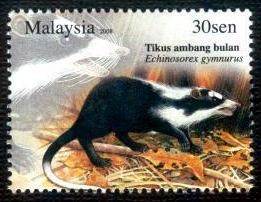











.jpg)



